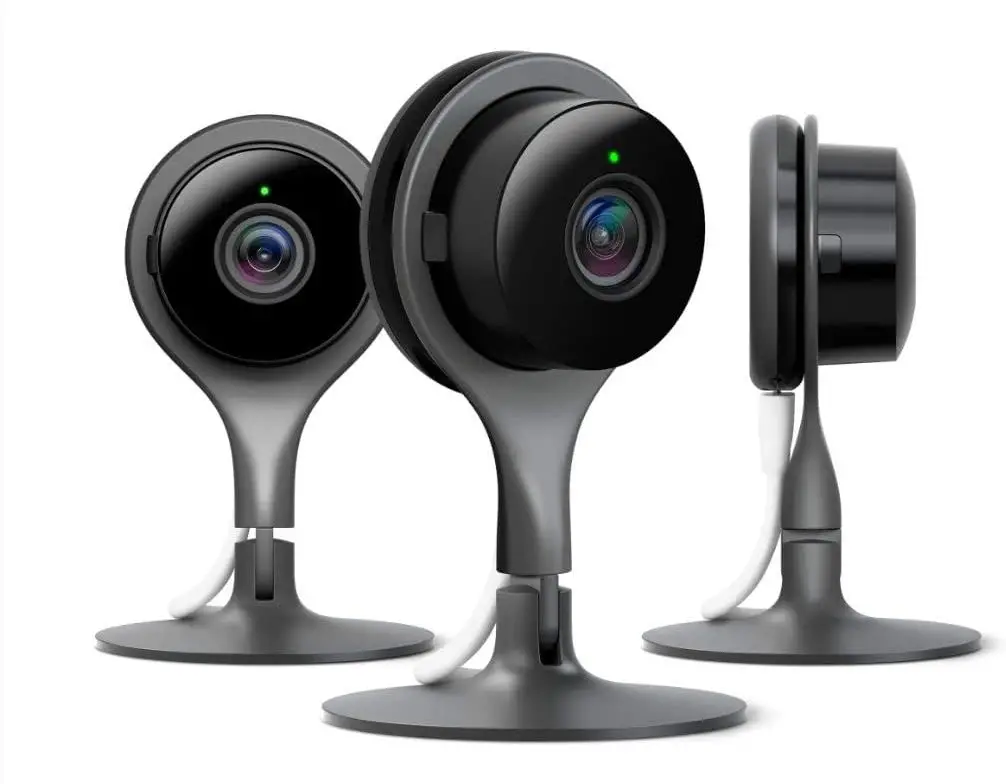Security is an area of the home in which smart technology is increasingly playing a role – and there are a number of advantages to protecting yours using a smart home security system.
Everyone takes a different approach to home security; some say they don’t want a viable alarm because it implies there are valuables worth the effort, while others are keen to create a visible fortress that will deter people, but will also take action or call first responders.
Whatever your attitude, smart home technology means there’s a solution that will improve your security.
That’s a good thing, too.
Many insurance firms are quietly adding to contracts that having a burglar alarm system is a requirement, and won’t cough up if you don’t.
The Guardian reported that in 2016 insurance firm LV= refused to pay out to two doctors in London. While they had simply been renewing their payments each year, the exclusions in the fine print had been updated to make an alarm a necessity, and the vague sentence ‘Check the document enclosed – we’ve added security clauses to your policy, please see your renewal quote’ in the covering letter hadn’t been enough to grab the busy couple’s attention.
The result: £6,000 (~$7,500) claim unpaid despite around a decade of payments.
Why install a smart home security system?
IT KEEPS YOU CONNECTED – a smart home security system is effectively a burglar alarm (with motion sensors) and wireless camera in one, both of which can connect your smartphone. This means you can monitor your home and see instantly what’s going on when there’s a disturbance, even when you’re miles away.
IT’S NOT AS EXPENSIVE AS YOU’D THINK – a basic smart home security kit starts at around $250 (~£200). You’ll need to add a camera and sensors to get the best out of it, but this does let you build up a system at an affordable pace.
SET-UP IS RELATIVELY SIMPLE – if it requires hardwiring to the mains, you’ll want to enlist the services of a qualified electrician, but many security elements are battery powered and not necessarily complicated to set up.
IT CAN INTEGRATE WITH EXISTING SMART HOME TECHNOLOGY – if you already have a Nest thermostat or Nest home surveillance camera, it’s worth checking if the system you’re thinking of buying is compatible. Samsung SmartThings works with just about anything. If you have smart bulbs, for example, you can program indoor and outdoor lights to come on at night-time, have lights turn on when you approach your house, and even switch on and off while you’re away.
IT’S CUSTOMIZABLE TO YOUR OWN HOUSE AND NEEDS – motion sensors, magnetic contact sensors for windows and doors, glass break sensors and pressure sensors can help to detect an intruder.
Monitoring
However installed, a big part of the home security industry revolves around monitoring.
Alarms that automatically called the police when triggered were a great idea in theory, but technology has its flaws and once you’ve had one or two ‘false positives’ (alarms that cry wolf), local police will stop respecting your alarm system.
The solution for some time now has been an intermediary: a monitored system that communicates with a team at the alarm suppliers who will first try calling you before notifying emergency services.
A plus side to this is that the alarm company suddenly has a massive financial incentive to reduce false positives, although you will need to pay a subscription fee.
One of the possibilities offered by a smart home security system is to remove that intermediary, and have the system notify you directly of an intrusion.
With the option of smartphone home security systems and more, you can look at the evidence and decide whether your neighbor’s cat has wandered into the garden again, or something more serious is going on, then you can call the authorities if needed.
That said, the proponents of smart tech are also able to see the potential that subscription services offer both the user and their bottom line, so some features on offer are still subscription-based.
Some smart home security cameras, for example, will only record via a subscription.
You also need to consider unavoidable risks.
You can only monitor a Wi-Fi camera remotely, for example, if the Wi-Fi is working, which means not only a good network but power to the camera and the router.
A traditional alarm might have a battery backup, but these new features are harder to ensure continuous supply of power.
How often does your internet connection go down? Are you affected by blackouts? These questions need to be taken into account when choosing your smart home security system.
Where to start?
Companies like Samsung do offer kits (i.e. SmartThings, see below) that will allow you to monitor, control and secure your home from your smartphone.
However, these are arguably more geared to managing your lifestyle than a serious security system – they don’t include an alarm.
Although you might be able to see an intruder who’s tripped one of your sensors while you’re away on holiday, it will be of little use if no siren is sounding to deter them, and limited connection where you are means you can’t get hold of the emergency services.
Combined smart home security systems are therefore the simplest and most affordable way to go if you’re serious about security.
Best Combined Smart Home Security System Kits
NEST SECURE REVIEW
Known for its especially chic designs, Nest – the Google-owned company responsible for the landmark Nest Thermostat – has brought an alarm system to the market.
It is shockingly expensive given what is included (let alone the price of additional sensors), but it’s hard to deny the elegance of the device.
The discrete keypad/hub/siren, or ‘Nest Guard’, comes to life when you operate it, keys lighting up as they do on a MacBook.
As well as the PIN, you can disable the alarm by tapping the Guard with one of the two-supplied key fob attachments – these use NFC technology just like contactless payment systems.
On top of the two entry-point sensors included, expect to pay approximately $59 for an additional one.
On the plus side, for those already using the Nest Cam security cameras, the devices can also be linked to the system, and it all operates through the same elegant smartphone app.
Also, check out my review of Nest Protect.
WHO WANTS IT? If you already have Nest cameras and thermostats, this takes your security to the next level, all working from the same app.
WORKS WITH: Google Assistant. No support for Alexa or any other smart home assistants.
INSTALLATION is relatively simple. The main hub does require power, but all the other elements are battery powered and can be easily set up through the app.
RING ALARM REVIEW
Ring’s first product was a smart doorbell, but it too has branched out into the smart home security marketplace.
The standard Ring Alarm kit includes a single door sensor, a single IR movement sensor, a cleanly designed keypad, which is battery packed (and a panel for wall mounting, if preferred) and a siren designed for indoor positioning.
The alarm can be set to home (the doors will continue to be monitored, but not the indoor motion sensors), as well as the traditional armed and disarmed.
A nice additional feature is a range extender, which can be placed midway between the keypad and a distant point of entry that might otherwise be in the sensor network’s dead zone.
Just like the Nest, the Ring Alarm provides a one app experience if you already have the Ring cameras and doorbells.
If you prefer not to monitor the alarm yourself (though you’ll still get the notifications), then a professional monitoring service – who will remotely disable or call you/first responders as appropriate – are just a monthly subscription away.
WHO WANTS IT? If you already have a Ring doorbell, this is an affordable way to secure the rest of your house.
WORKS WITH: No support for smart home assistants.
INSTALLATION: Another easy installation as all the elements are battery powered. Set up is well guided through the Ring app.
Check out my hands-on review of the Ring Security System here.
Adding sensors
The easiest way to expand these kits is to buy additional sensors, but do remember that none of the three kits talked about above will be able to add third-party sensors to them.
You either buy them all from the company, or don’t.
AND IF YOU DO WANT TO DIY…
SAMSUNG SMARTTHINGS STARTER KIT REVIEW
Platforms like Samsung SmartThings allow you to buy and combine its sensors and third-party sensors through a smart hub.
Even though it can be cheaper to build your own security this way, you do lose features such as being able to subscribe to an outside service that will monitor your system and call the emergency services.
As well as the hub, the box contains a motion sensor, door/window sensor, smart plug and tag sensor.
The tag sensor comes with a separate fob, which can be attached to a key ring.
The sensor will then alert you when the fob’s holder has arrived home – great if you want to keep tabs on your kids, for example.
A camera isn’t supplied with the kit, but Samsung SmartCam SNH-P-6410 can be bought separately and connected to the system for an extra cost.
WHO WANTS IT? Anyone interested in upgrading your home to a smart one.
If you’re purely after a security system, you need to be aware that no alarm means it’s unlikely to deter thieves from breaking in, it doesn’t have a siren and there’s nothing supplied that will alert burglars to its presence.
WORKS WITH: Amazon Alexa and Google Assistant.
Also compatible with an array of smart tech from other brands, including Philips Hue light bulbs and Yale keyless smart locks.
INSTALLATION: Simple to set up and the app is easy to navigate.
Also lots of ways to personalise it, such as programming a range of actions to happen at the touch of a button or activation of a sensor – for example, you could set a light to come on (using the smart plug) when the motion detector senses movement.




